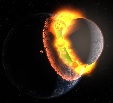|
Sirius B Space Warping
|
|
| Tails | Date: Monday, 06.07.2015, 02:13 | Message # 1 |
|
Observer
Group: Newbies
 Australia
Australia
Messages: 2
Status: Offline
| The Sirius brothers are pretty easy to find and I'm sure we've all been to them. Something that has always tickled my curiosity - why does Sirius B have a warping animation similar to neutron stars and black holes, of which I am sure it is neither? It's pretty pint sized, at only 1.4 solar mass. Is it something to do with its gravity? 3.1 X10(5)g.
|
| |
| |
| Alek | Date: Monday, 06.07.2015, 03:55 | Message # 2 |
 Pioneer
Group: Users
 United States
United States
Messages: 326
Status: Offline
| It has to do with the star's intense gravitational field because it's so dense but with a mass similar to the sun.
Living among the stars, I find my way. I grow in strength through knowledge of the space I occupy, until I become the ruler of my own interstellar empire of sorts. Though The world was made for the day, I was made for the night, and thus, the universe itself is within my destiny.
|
| |
| |
| parameciumkid | Date: Monday, 06.07.2015, 07:14 | Message # 3 |
 Explorer
Group: Users
 United States
United States
Messages: 277
Status: Offline
| ^ This. Even the Sun produces a gravitational lens effect (IRL, which is one of the ways General Relativity was verified), but it's very subtle and near imperceptible (and it doesn't help that the Sun's way too bright to stare at that closely). The effect's severity depends on the gravitational gradient, which is a function of density more than mass. So even a small object like Sirius B, if packed densely enough, which it is, will produce a visible distortion. Degenerate matter (the stuff of white dwarfs) is hella dense; it just doesn't get as much attention as neutron star stuff.
Intel HD Graphics 4000 ;P
|
| |
| |
| Watsisname | Date: Monday, 06.07.2015, 09:22 | Message # 4 |
 Galaxy Architect
Group: Global Moderators
 United States
United States
Messages: 2613
Status: Offline
| Above posts are correct: gravitational field deflects the paths of light rays. The cool way to think of this is that the light rays are actually moving in perfectly straight lines through space-time, but the space-time is curved by gravity, so that those straight lines appear curved.
I'll spare most of the math but show a simple formula you can use to calculate this. This assumes the light ray passes a distance "b" from a point mass "M", and also that b is much greater than the gravitational radius 2GM/c^2. Most celestial objects are essentially spherically symmetric, and their external gravitational fields are therefore essentially the same as from point masses, so this formula works for most cases besides very close to black holes. For Sirius B, it's pretty good.
The deflection angle is given by

For Sirius B, massing ~1.4 solar masses and with a radius of ~7700km (about the mass of the Sun in about the volume of the Earth, as with most white dwarfs), this equation tells us that the deflection angle of a photon skimming its surface will be about 1x10-3 radians, or 0.06° (3.7 arcmin). This isn't very much compared to a black hole or even a neutron star, but it is quite significantly more than the lensing at the Sun's surface (~1.7 arcsec!). This makes white dwarfs effective objects for microlensing studies. 

|
| |
| |
| Tails | Date: Monday, 06.07.2015, 12:37 | Message # 5 |
|
Observer
Group: Newbies
 Australia
Australia
Messages: 2
Status: Offline
| You are all excellent, thank you kindly!
|
| |
| |
| apenpaap | Date: Monday, 06.07.2015, 17:35 | Message # 6 |
 World Builder
Group: Users
 Antarctica
Antarctica
Messages: 1063
Status: Offline
| Quote Watsisname (  ) For Sirius B, massing ~1.4 solar masses and with a radius of ~7700km (about the mass of the Sun in about the volume of the Earth, as with most white dwarfs), this equation tells us that the deflection angle of a photon skimming its surface will be about 1x10-3 radians, or 0.06° (3.7 arcmin).
Does SE actually use these calculations? The gravity lensing around white dwarfs looks far stronger than that figure would indicate. Sirius B has an Einstein ring quite a distance from the surface when seen up close.
I occasionally stream at http://www.twitch.tv/magistermystax. Sometimes SE, sometimes other games.
|
| |
| |
| Watsisname | Date: Monday, 06.07.2015, 19:27 | Message # 7 |
 Galaxy Architect
Group: Global Moderators
 United States
United States
Messages: 2613
Status: Offline
| Yeah, I believe SE's depiction of white dwarf lensing is too strong.
The lens equation can be written in a form for the angular size of the Einstein Ring (see equation 3.6 on page 26 of these lecture notes.
If we take a distant light source like a background star, then this formula tells us that the size of the Einstein ring caused by the white dwarf will be smaller than the apparent size of the white dwarf for an observer within about 7 million kilometers from the dwarf (beyond this distance, the ring is visible). But SE renders the ring much larger / from closer distances than that. It's possible that I'm wrong here, since for strongly curved spacetime the assumption that dL+dLS=dS is not valid. But I think it's still a good enough assumption in this case.
I should emphasize though that a few million kilometers is still an impressively small distance to observe Einstein rings from an object. White dwarfs are very dense. 

|
| |
| |
| Himself | Date: Tuesday, 07.07.2015, 05:59 | Message # 8 |
|
Astronaut
Group: Users
 United States
United States
Messages: 45
Status: Offline
| I had noticed that the Einstein ring around black holes seemed a bit too large in comparison to the event horizon.
|
| |
| |